There are a large number of species of Tropical Birds in the world, most of which live in jungle areas or near the sea where the warm and humid climate gives them perfect conditions for their development. We invite you to read this article to discover the main Tropical Birds that stand out for being famous, thanks to their dazzling beauty and other qualities.
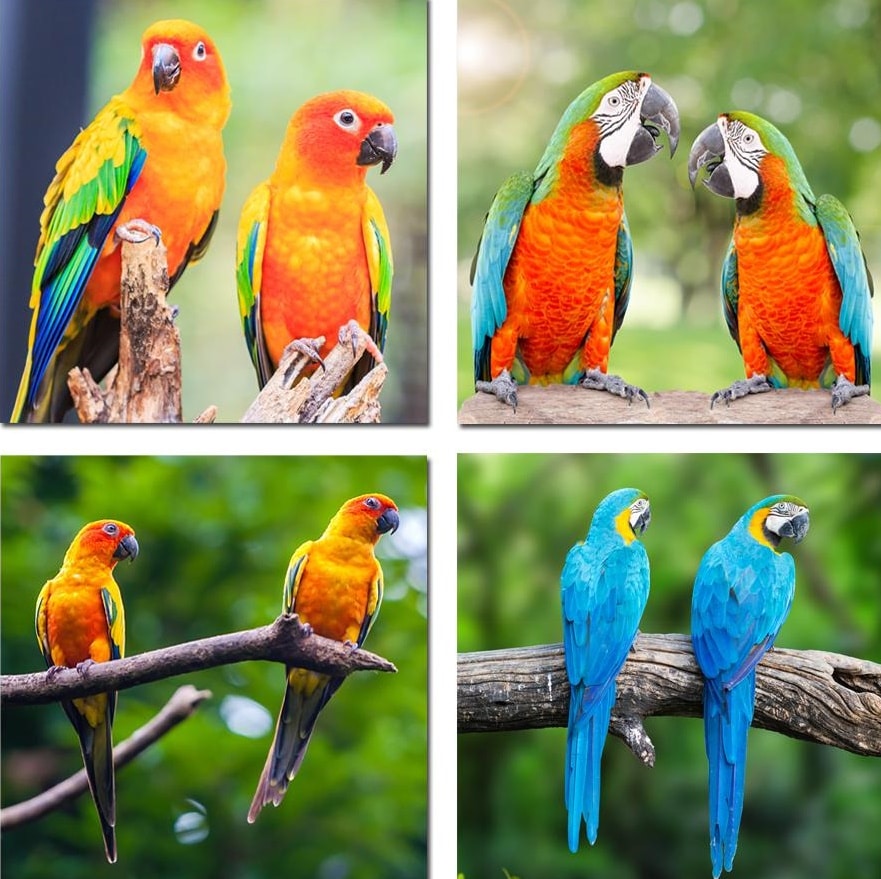
Overview of Tropical Birds
They are all those coming mainly from the tropical forests of America, Africa, South Asia and Australia. These birds are distinguished by their great diversity, striking plumage with extraordinary colors and magnificent and incredible songs, some even consider them very noisy. They are omnivores that eat seeds, fruits and insects. In the tropical forests there are innumerable species, some of which are very famous, such as the turpial and cardinal in Venezuela, the quetzal in the jungles of Guatemala, Mexico and Costa Rica, where there are also hummingbirds and toucans.
Another country with this type of extensive fauna is Brazil, especially its original pendulum bird from its Amazon jungle, a species that also lives in other parts of Central America and the Caribbean islands. In Colombia, its curious and endemic species is the red-billed toucan. The yaco and the lovebird originate from Africa. While cockatoos and parakeets come from Australia. And so there are many other famous birds of tropical areas, which we will provide you with all the information below so that you can learn more about them.
Tropical birds when they are kept in captivity, it is important to take into account the space, since some of these birds need a large cage or an aviary, while others may have a smaller cage, and to guarantee a healthy diet they can be given a combination of seeds together with concentrated foods that contain some necessary components for a good diet and of course some fruits and vegetables.
the australian parakeet
It is a small exotic bird native to Australia, with green and yellow colors that are the most traditional, there are also blue, white, gray or other shades that have resulted from the crossing of these. It can reproduce twice a year in spring and autumn. They feed on birdseed, millet, wheat and oats, they are also given lettuce, chard, spinach, carrots, bananas or apples. In addition, you must cover their needs for iodine and calcium by purchasing them at stores in the industry.
When they are in their natural habitats, these tropical birds often form large bands during migratory seasons. In addition, it is important to highlight that given the peculiarity of being extremely sociable with people, they are one of the most popular exotic species in homes and because they require basic maintenance, such as frequent water changes in their drinkers and cleaning of their cages. Likewise, it should be considered that it is a species that reproduces rapidly.

golden conure
This species of tropical bird is of great beauty and has a large part of its body with golden yellow plumage that changes to bright red-orange tones. The forehead, crown and nape are bright yellow with orange tones. Bright yellow color on the coat, back and torso. Yellow upper tail coverts with exotic blue feathers. Green badge with blue tips and inner wings; the smallest and medium caches, yellow with variable green spots; large covers tipped yellowish-green, primary covers blue.
Flight feathers, green above, primaries with blue tips and inner blades, grayish brown below. Yellow (or orange and yellow) undertail coverts. The throat is orange with a yellow cast on the upper chest, while the lower chest and belly are orange. Above, the tail is mostly yellowish green with blue tips; below, gray with a yellowish tinge. Its bill is dark brown to black, the iris is dark brown, and it has brownish legs.
They usually live in savannas, in dry forests with palm trees, and sometimes in flooded areas up to 1200 m. They only cross the more open habitats when moving between forest areas. They are social tropical birds usually seen in flocks of 30 or more individuals. As for reproduction, it can be said that it nests in holes in trees or palm trees where there is only one chick. The average clutch size is 3 to 4 eggs, which are incubated for 1 month. This is almost forty percent more than other birds compared to egg mass.
The diet of these tropical birds is poorly documented, although it probably consists of locally available foods such as fruits, berries, or flowers. Some known foods include legumes, red cacti, and possibly Malpighia berries. In terms of their geographical distribution, they are found in northeastern South America, from Mount Roraima in the extreme north of Brazil, areas adjacent to the Sierra de Pacaraima in Venezuela and northern Guyana, to the Pomeroon River, east to through Suriname and French Guiana to Brazil at Amapá.
Although they have also been observed in Pará and the eastern Amazon (in the west around Rio Branco and locally in the southern Amazon, from Santarém to the Rio Canumá region). However, they can be considered common. Sporadic records indicate a local presence of this bird over a wide area of its range. It is kept locally as a domestic bird and is captured for the live bird trade.

hyacinth macaw
This type of tropical bird is one of the largest parrots and has a distinctive coloration, mostly deep blue, with various shades. Wings and tail below black. The base of the beak and the periocular ring with a slightly bluish tint. The tail is very long and its strong black bill is deeply curved and pointed. The similar but smaller species Anodorhynchus glaucus, which became extinct in the early XNUMXth century, may have occurred in Bolivia.
On the other hand, it enjoys a wide variety of habitats full of large-seeded palm trees, which it feeds on. In the forest of northern Brazil, it prefers lowland forests and humid seasonal formations with cleared areas. But in the drier parts it inhabits plateau lands cut by rocky valleys, steep with closed deciduous trees, gallery forests and marshes with Mauritia flexuosa. In the Pantanal region, birds frequent gallery forest with palm trees in areas covered with moist grass. Apparently, it carries out migratory movements. It is usually seen in pairs, family groups or small groups.
Regarding their reproduction, we can say that they nest in large tree holes, in the rocky crevices of the cliffs of northeastern Brazil. Preferred nesting trees in Mato Grosso, Brazil include Enterolobium and Sterculia striata. In northeastern Brazil, nesting occurs in dead Mauritius palm trees or on cliffs. They usually lay one or two eggs, although a single young usually survives if the second egg hatches a few days after the first.
On the other hand, it is worth noting that the incubation period lasts about a month and the male will take care of his partner while she incubates the eggs. The young pups remain with their parents until they are three months old. These then reach maturity and start reproducing at around seven years of age. In turn, it is important to point out that the breeding season is from August to December, perhaps a little later in the Pantanal regions.
Their diet consists mainly of nuts, available locally from various palms, including Maximiliana regia, Orbignya martiana and Astrocaryum, in northeastern Brazil, from Syagrus coronata and Orbignya eicherir, in swampy areas from Scheelea phalerata and Acrocomia. Palm nuts are extracted from the plant or from the soil itself (especially after a fire or when they are available as undigested remains in cattle feces). Other fruits for which information is available are those of Ficus sp., as well as the Pomacea aquatic molluscs. Birds drink liquid from the fruits of the green palm.
Its distribution includes the interior of Central South America, possibly in several separate large areas. In the Amazon Basin in Pará from the Tapajós River, east of the Tocantins catchment, south, possibly northwest of Tocantins. At least before the present, the northern Amazon (in Amapá, Amazonas and Roraima, Brazil) and perhaps some more specimens may inhabit, although no recent records are known. Also distributed throughout northeastern Brazil, more or less centered in the Chapadas das Mangabeiras microregion at the junction of Maranhao, Piauí, Goiás, and Bahía, Brazil (Gerais region).
A third significant population is concentrated in swampy habitats in the upper Paraguay River area in southwestern Mato Grosso, Mato Grosso do Sul, Brazil and extends into adjoining eastern Bolivia and extreme northern Paraguay. Reported as probable for the Mapori River in southeastern Colombia (Vaupés). General but perhaps seasonal movements in the Amazon in relation to the ecology of the plants they feed on. The territory between the current three main distributions may still be occupied, although recent trends seem to indicate that this would be unlikely.
Parrot Chiripepe
When describing this species of tropical birds, it can be noted that it has a narrow and dull red frontal band with some brighter red feathers behind the cere, blackish lords, cheek and crown feathers, grayish green with blackish tips; ear coverts olive green. The upperparts are grassy green with a small reddish area on the lower back. Primary coverts bluish-green, wing coverts grass-green, some feathers sometimes tinged with olive.
As for the primaries, they are blue in the outer webs and green in the inner ones, with dark tips; the secondary ones, on the other hand, are mostly green. Sides of the neck, throat and chest, olive brown, subterranean brown feathers and black tips, giving the whole a scaly effect. The lower part of the breast is green with a brown spot in the center of the belly, flanks, thighs and undertail coverts green. Above, the tail green in the basal half, tinged bronze to reddish tones at the ends; below, the tail is dull brown.
This type of tropical bird has a gray bill, sometimes paler at the base of the mandible, yellowish cere, whitish gray orbital ring, and dark brown iris. In addition, it should be noted that its legs are dark gray. It can be noted that the external and physical characteristics of both sexes are similar. The fledgling does not have the brown color on the belly. Immature paler than adult with darker iris. They encompass various habitats of forests, jungles, fringes, and swamps, including the remaining patches of araucaria.
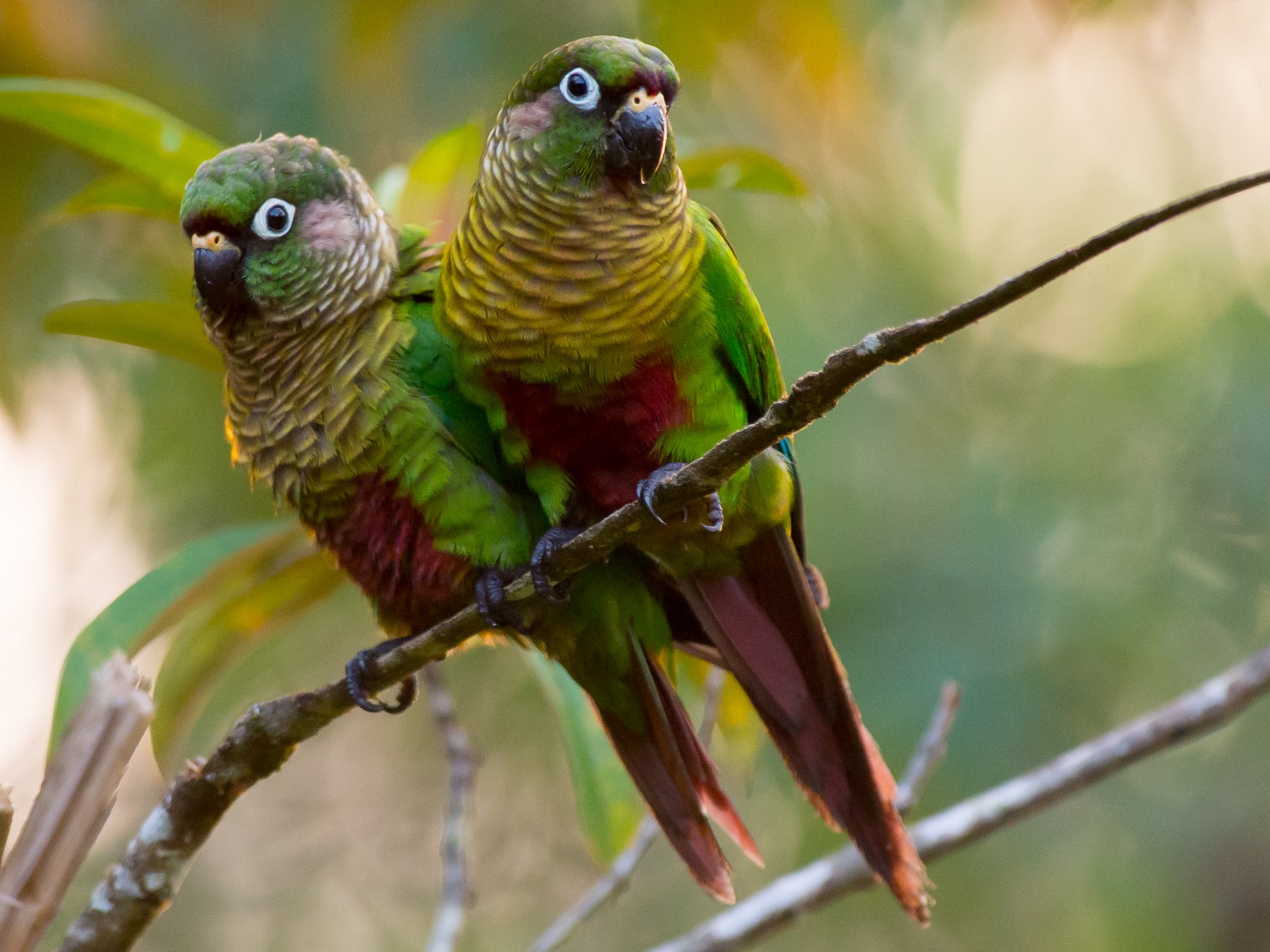
In the Paraguayan Chaco, they appear to be almost confined to riparian growth zones along the Paraguay River and its main tributaries. In southeastern Brazil they are found mainly in the mountains at 1.400 meters above sea level; in other parts of the lowlands up to about 1.000 meters, where they are resistant to interference, they even visit urban parks in the cities of Asunción, Rio de Janeiro and São Paulo and eat in orchards (Rio Grande do Sul). They live together, usually in flocks of 6-12 birds up to 40.
They nest in the hole in the tree. The breeding season includes the months of October to December. Mating of 5-6 eggs. The female incubates alone for almost 30 days. The young leave the nest after about 45 days, after which they continue to be fed for a while by both members of the pair. Its diet includes pulp of Euterpe edulis, seeds of Schinus, Xylopia, Cecropia, Croton, Miconia, ficus, Psidium and Pinus; Ambrosia and Vernonia flowers and Protium Aril. In other places, the Araucaria is a very important food source.
In addition, it should be noted that it is endemic to southeastern South America, southeastern Brazil and northern Argentina. In Brazil, they can be observed from the south of Bahia over the coastal states to Rio Grande do Sul and to the west in the southeast of Minas Gerais and south of Mato Grosso passing through Paraguay (the extension of the records suggests their presence in the distant west), in the north of Uruguay and in the north of Argentina, in Misiones, Corrientes, Formosa, Chaco and in the past sporadically in the north of Santa Fe and in the southeast of Bolivia.
Cacique parrots, also famous tropical birds
This species is unmistakable for its radiant colors. It has a yellowish-white forehead and crown, fading behind to brown with pale streaks on the nape, and is fringed with elongated, frill-shaped feathers that are burgundy red at the base and bright blue at the tips. Brown parrots have brown cheeks, throat, sides of the neck and eyebrow, heavily streaked with yellowish tones. The upper parts are green. The median and lesser wing coverts are green with dark blue primary coverts.
Blackish primaries, green secondaries with dark tips. Underside, green wings, blackish flight feathers. Green chest and belly sides; burgundy red center of breast and belly tipped with blue, creating a blue and red streak effect, sometimes with a little green, especially on upper breast; thighs and undertail coverts green. Above, the tail is green with blue tips, blue outer feathers on the outer webs and hidden red at the base of the inner webs; below, the black tail. Blackish bill, paler at the tip, black cere, yellow iris, and dark gray legs.
This type of tropical bird lives in the lowland rainforest and prefers places with solid ground, including slightly undulating terrain or hills (possibly due to a greater variety of plants on which they feed). It apparently avoids Várzea forests, forest edges, and clearings, but there is a report of birds in flooded forests in the Morona River drainage, Peru, and they feed mainly in riparian forests in Venezuela. It reaches barely 400 meters in the southeast of Colombia and 200 meters in Venezuela.
It is not usually found in large groups, they are divided into pairs or small groups of 3-4. Rarely up to 10. Prehatching aggregations appear to split into pairs or trios at start of nesting. They perch on the tops of trees in small groups (perhaps also alone in tree cavities). Feeds mainly in the canopy. Also, they are not very social. They display a raptor-like appearance, displaying the feathers on the back of their heads like a fan.
They nest in hollow trees, including an old woodpecker nest, for example a red-necked woodpecker (Campephilus rubricollis). Rapid flapping of wings, followed by gentle gliding descent, results in deeply undulating demonstration flight during breeding season. Reproduction that occurs between March-June in Venezuela; January-March in Guyana; February-April in Suriname; between December-February, in Brazil. It feeds on leaves and shoots of Bombacopsis, immature fruits of Dialium, fruits of Euterpe, Attalea, fagifolia, Astrocaryum. It also consumes inga and guava in cultivated areas.
In summary, it can be noted that it is a very intelligent, playful and very beautiful bird. However, despite its undeniable attractiveness, it is not an ideal species to keep in captivity. They are extremely nervous and sometimes this means that they pluck or bite their feathers causing damage. They are extremely noisy parrots and having a copy at home does not seem very tolerable, but rather a difficult test for our patience.
Toucan
It is one of the tropical birds native to the southern part of the American continent, with black plumage contrasted with intense yellow on the neck, its large colored beak can measure up to a third of its size (about 14 cm). They are the birds that have the largest beak compared to other tropical birds. It has small, short and rounded wings. The tail is square in some species. The eyes are surrounded by skin that is sometimes light in color.
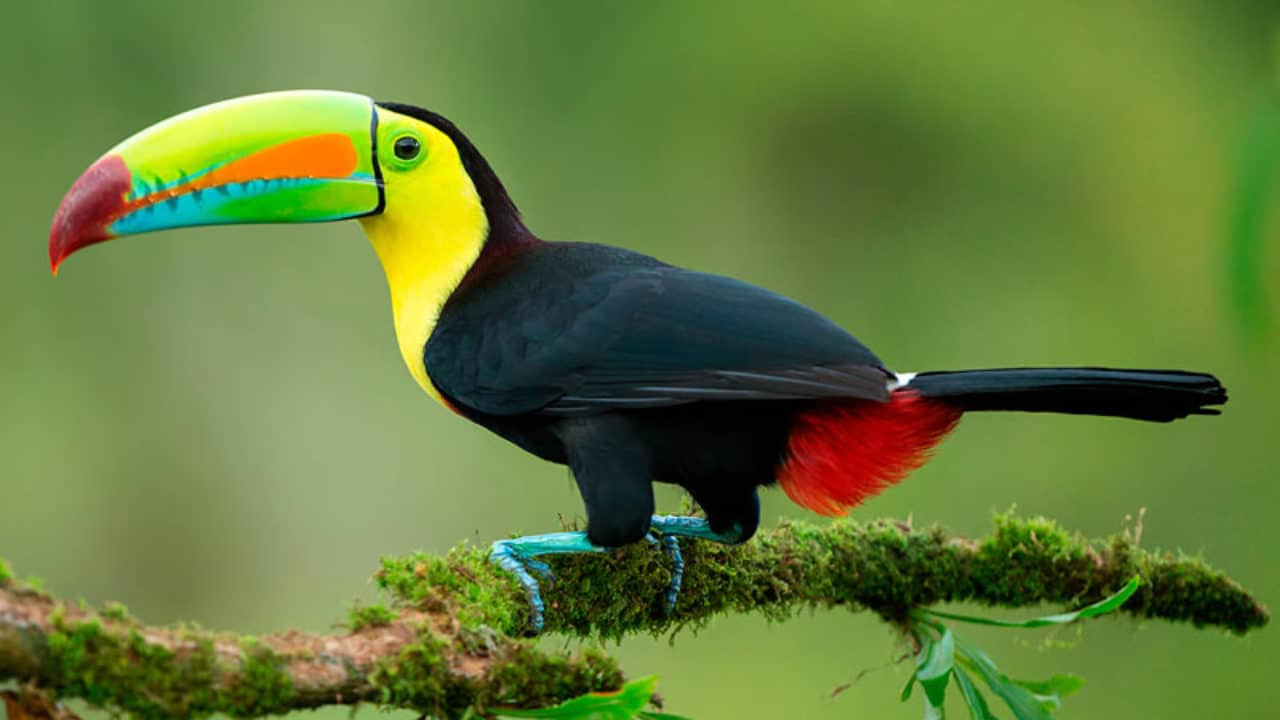
On the other hand, they were cataloged under the Piciformes order and the Ramphastidae family. That includes 6 genera and about 40 species. Toucans measure between 18 and 63 cm and the Toco toucan is the largest. The toucan lives in the jungle but sometimes prefers and moves to humid forests and even colder areas. It lives in the treetops of tropical, subtropical, and lowland rainforests. Its location extends from Mexico, through Central America, to northern Colombia and northwestern Venezuela.
The bill not only works to protect itself, it is also used to grab the fruits and vegetables that are found in the thin trunks. Being supplemented with insects or some small creatures, including other birds and their eggs. Additionally, they are friendly, living in flocks of around twelve members. Much of their existence is spent in the trees, so they are not migratory birds and are usually found in pairs or small flocks. These tropical birds nest in the hollows of trees and lay 2 to 4 white eggs and the incubation period is 43 to 46 days, both male and female take care of them.
At birth, the young are featherless and keep their eyes closed for about three weeks. They remain in the nest for eight to nine weeks while their beak fully develops and prepares to fly. When young, they have a shorter bill than adults, but there is little difference in plumage by age or sex. Their vivid colors allow them to blend in with the dappled light of the forest canopy. However, these birds often make monotonous sounds or produce a very primitive chirp, suggesting that they are not trying to stay hidden.
When distinguishing each of the species of this type of tropical bird, mention can be made of the variety of its characteristics in terms of its plumage or its beak. For example, it is known that those that inhabit the area of the Amazons and the Andes are the largest, reaching more than half a meter in length. However, there are some that are smaller, such as the aracari, which lives in the humid forests of Central America and north of the South American continent.
Although this bird has a large number of genera, the two predominant species, it is critically endangered. They have been hunted with some intensity, but the main reason they are critically endangered is habitat destruction. The deforestation of forests, pollution, the growth of urban areas and biopiracy are some of the most obvious manifestations. Currently, this species is in danger of extinction due to habitat changes and the slow reproductive cycle in which it only lays 2 eggs a year and which is difficult to achieve with climate change.
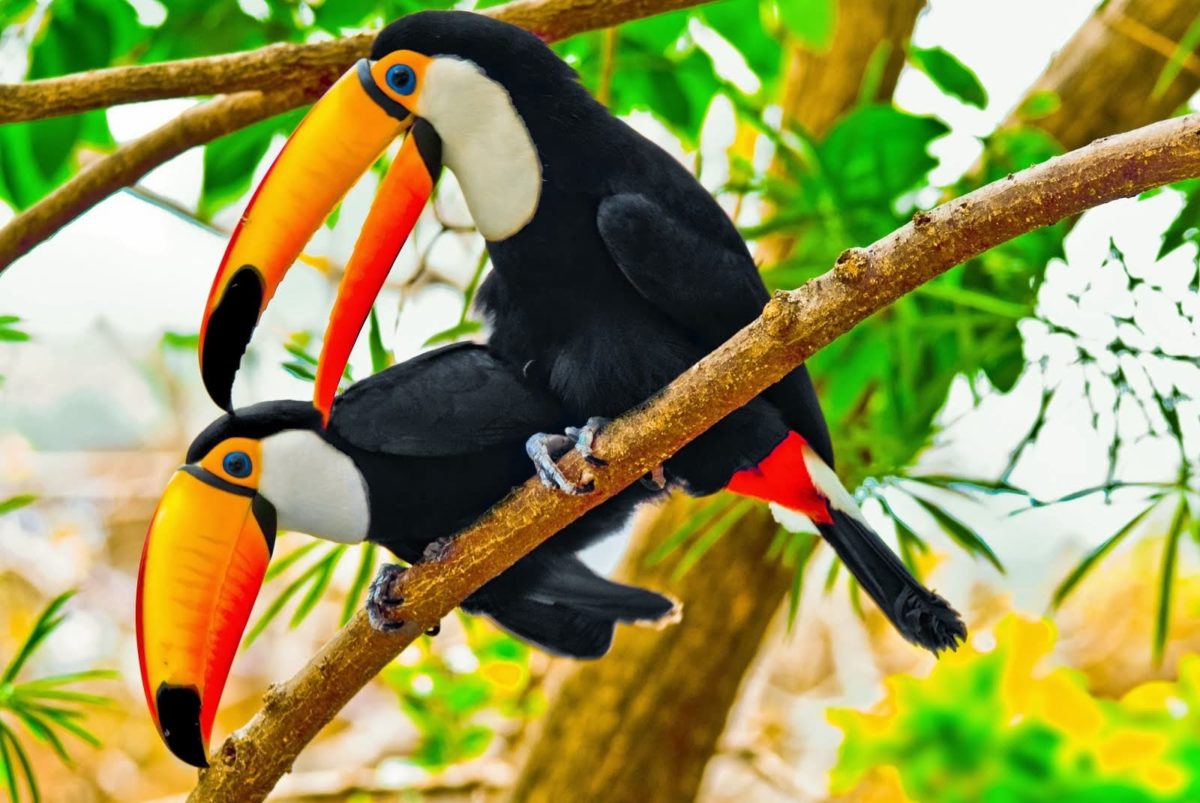
Galerita Cockatoo
It is a species of large tropical birds with predominantly white plumage. In adults, the ear flaps, neck and cheek feathers are pale yellow, the edge formed by the 6 erectile feathers tilted forward, is yellow. The beak can reach up to 14 centimeters in length. The underside of the wings and tail are light yellow. The ring around the eye shows a white color. The iris is dark brown in the male and reddish brown in the female. The bill is blackish gray, the legs gray. The young barely differentiate their irises are light brown.
They are very noisy and easy to see, although they are best recognized by their cries. During the breeding season they live in pairs or small family groups, but the rest of the year they live in flocks that can number in the hundreds. They behave in a familiar way in urban areas and in places equipped with feeders. In other places that arouse their usual suspicions and cunning, they are very difficult to reach. In open areas, these birds implement an organized guard system as follows: while most of the flock is eating, some birds watch from a nearby perch and tend to sound the alarm if there is danger.
Found in a variety of wooded areas, forests (including swamps and riparian areas), mangroves, open land, on agricultural land (including rice fields and palm plantations), savannas, mallee, and suburban areas. Found up to 1500 meters in parts of Australia, 2400 meters in Papua New Guinea. In Australia, the mating season is between May and August in the north and between August and January in the south. In New Guinea it takes place during all months of the year, although the most active months are between May and December.
This species sometimes breeds in colonies. The nest is a natural cavity in a large eucalyptus tree near a stream between 3 and 30 meters above the ground. Sometimes the residence is located in holes in the limestone cliffs along the Murray River. In this case, the eggs are deposited directly on the sand. In New Zealand, these birds are found amid hay bales in barns. The nest usually contains 3 white eggs. These are deposited in a layer of decomposing debris at the bottom of the cavity.
On the other hand, it should be noted that, within the incubation process, both parents do so alternately for a period of 30 days. The young are yellowish in color and leave the nest after 6 to 9 weeks. In addition, it can also be mentioned that, quite regularly, these tropical birds return to the nest to rest for about two weeks. The young remain in the family group for several months. They feed together in small scattered groups.
As for their diet, it is made up of herbs and grasses, as well as some corn and wheat shoots. It also feeds on noxious herbs such as milk thistle. Other foods include: roots, rhizomes, nuts, berries, flowers, bulbs, blossoms, and insect larvae. They can cause significant damage to crops. They dig into recently planted soil eating the ripe fruit, this also damages stored crops and hay bales from which they tear the plastic covering.
On the other hand, we can say that, in terms of geographical distribution, this species is endemic to northern and eastern Australia, New Guinea and neighboring islands, especially the Aru Islands, Indonesia. It has been successfully imported to the Palau Islands in Micronesia, New Zealand, and some of the Moluccas. The Taiwanese population has been estimated at around 100 introduced breeding pairs. Lives primarily below 1000 m, but can occasionally be seen in Australia at 1500 m and 2000 m in eastern New Guinea.
Flag Cockatoo
It is distinguished by its spectacular crest made up of 16 long feathers that curve forward. These feathers have a broad base with a slightly pink central part flecked with yellow-red. The upper ends of the crest are white. Another set of more rounded feathers grows over the eye, forming a white base when the crest is raised. The front is crossed by a fine reddish band. The face, neck, and underparts are salmon-colored, fading to white on the covers.
The flight and tail feathers are white with salmon infiltration on the underside. The beak is almost white. The irises are dark brown and the legs are grey. Female resembles her mate, but lighter salmon-pink head and underside. The yellow stripe that decorates the note is brighter and wider. The upper part of the belly is white instead of salmon pink. The irises are reddish pink. The young are identical to the female. The front stripe is bright reddish orange, the iris light brown.
Regarding the behavior of these tropical birds, it can be said that the pair is the basic social unit, but they maintain contact with other non-breeding pairs through the formation of groups. Outside of the breeding season, there are mainly small flocks of 10 to 50 birds. The largest gatherings are held only in times of drought or when food sources are plentiful. In this case, there may be a hundred people. The common niches are occupied exclusively outside the breeding season and the birds depart early at dawn.
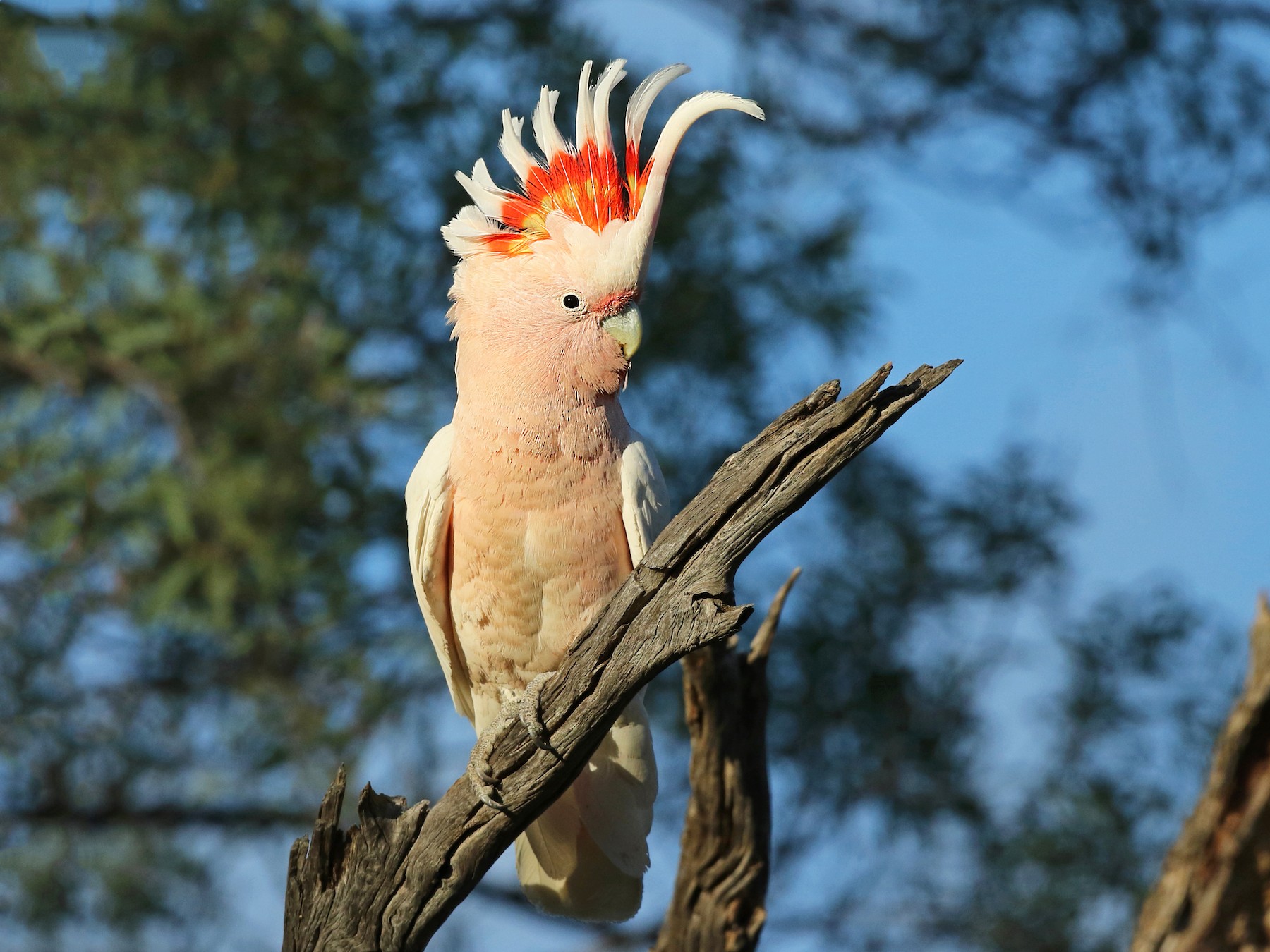
They look for food in the trees and on the ground. Moving across the ground, they walk slowly to avoid tall grass. In the flock, one bird always plays the role of sentinel. It adopts a very cautious attitude, partially bristling its crest, and regularly takes breaks during which it stands tall observing its surroundings. During the midday heat, it takes refuge in the foliage of the trees. During the summer, the rest period is longer. Paired birds are always close to each other. In periods of intense heat, this bird visits water points, at sunset, it returns.
Its population is distributed over a wide variety of forest habitats in arid or semi-arid areas. The species is closely related to mallee areas. They are found in particular in the reforestation of cypresses and eucalyptus, in mixed plots of eucalyptus and casuarinas or near cliffs. Their presence in a place is also largely due to the existence of a water source. On the other hand, it shows a very weak attachment to fragmented habitats where it does not stay for long.
The nesting season runs from August to December. Cockatoos return to their traditional nesting sites. The nest cavity receives improvements: the entrance is widened and covered with a layer of fresh shavings placed at the bottom of the nest. The nests are almost always far from each other, at a distance of about 2 km. The laying has between 2 and 5 eggs that are deposited between 2 and 3 days. Incubation is carried out by both parents, begins after the deposit of the third egg and lasts between 23 and 24 days.
The chicks remain in the lower part of the cave for 57 days and are fed by males and females. The family stays near the nest until the last young leave the nest. They then join other family groups where food resources are sufficient. In rare cases, the flag cockatoo is forced to chase away a pair that has begun to lay eggs in their nest, but this form of parasitism can also be successful.
They feed on seeds, grasses, grains, and often melons. They also consume fresh local figs, pineapples, eucalyptus seeds, onions, nuts, roots, insects and larvae. During and after feeding, these birds collect branches and pieces of bark and create a rain of wood chips at the foot of the trees. Also, when the heat is intense, they increase the frequency of their visits to the watering holes. These birds are native to Australia and their main strengths are in South West Queensland, where they are widespread, and South Australia, where they are local.

Cuban Aratinga, another of the tropical birds
It has a strong, hooked beak, exhibiting the ability of both the upper and lower parts to move, which enables this parrot to peel and crush the seeds, fruits and nuts dropped by many other birds, thus showing another successful feature of this tropical bird. Its legs have a magnificent grasping capacity that allows it to take incredible poses and grab onto extreme places thanks to a toe arrangement with two fingers forward, 2 and 3, and two backwards, 1 and 4.
Its head, sides of the neck, and neck are grass-green with a few scattered red feathers that sometimes form spots. Grass green upperwing caps and guard, primary and secondary with dark green tips and margins to capture the interior; carpal edge with scattered red feathers and its wing is curved and red. Underwing coverts with golden-brown flight feathers, red lesser and median coverts, and olive-yellow greater coverts.
Yellowish-green underparts with extensive olive coloring, sometimes with isolated red feathers, especially on neck and thighs. Above the tail dark green with an olive tint, below yellowish brown. Light-colored bill, bluish-white orbital ring, yellow iris, and brownish legs. The female has more orange color on the wings. Juveniles have green and red underwing coverts, a yellowish (not red) leg margin, gray irises, and no scattered red feathers.
This class of tropical birds lives in the savannah, especially in areas where Copernicus and Thrinax palms are common, on the edges of forests and in areas with abundant trees. However, there is good evidence that they were found in places that have been somewhat modified, such as eucalyptus forests in open country and evergreen forest fragments in palm savannahs. Furthermore, it can be said that the species only survives near large areas of primary forest.
One of the main reproductive problems of this species is finding nests and competing for them. It is small so its physical advantage over other birds to displace them from the nests is less and they must show greater aggressiveness to be able to expel woodpeckers and even some small birds of prey. However, recent studies suggest that in free life this species does not have a high degree of selectivity due to the height of the palm in which it will nest or the depth of the nest, which is in the mating stage and is not evident in strong nest of signs of cordiality.

However, there might be some tendency to prefer nests with an entrance opening narrow enough to allow the pair to enter and hinder predators from entering. It also seems that the breeding species is more tolerant of other neighboring pairs of the same species than with other parrots, but to some extent spaced out, favoring palm trees where there is only one cavity where there is a certain degree of privacy when breeding their parrots. .
The breeding season begins in April and usually ends in July. They sometimes build their nests in cavities originally excavated by the Tajá woodpecker (Xiphidiopicus percussus). The number of eggs laid averages between three and five. Incubation is carried out by both members of the pair and the young are fed until they leave the nest. Once the nest is vacated, the immatures can be seen flying in small flocks with the parents before the winter season, and forming larger flocks when different families join.
The diet of this class of tropical birds consists of mangoes, papayas, guavas, Roystonea palms, fruits of Melicoccus bijogatus and Spondias mombin, as well as seeds, shoots, millet and Inga berries. They even fed on coffee and corn seeds, which is why they were hunted long ago by the population, because they caused enormous damage to crops. Previously it was one of the endemic birds of Cuba and Isla de la Juventud, but now it is limited to various dreadlocks in remote areas of the Caribbean island.
In captivity, they are very rambunctious and somewhat contentious and restless and always need to be monitored. Little communicative in the emission of words, although very friendly with the person they choose as a partner who will not get rid of a pleasant evil, almost always tolerated and even grateful. Sensitive to the changing conditions of the ecosystem in which it lives. The requirements and difficulties for the propagation of this species are considerable. Keeping this beautiful bird as a pet can be interesting, although its small population makes it a bit difficult to keep.
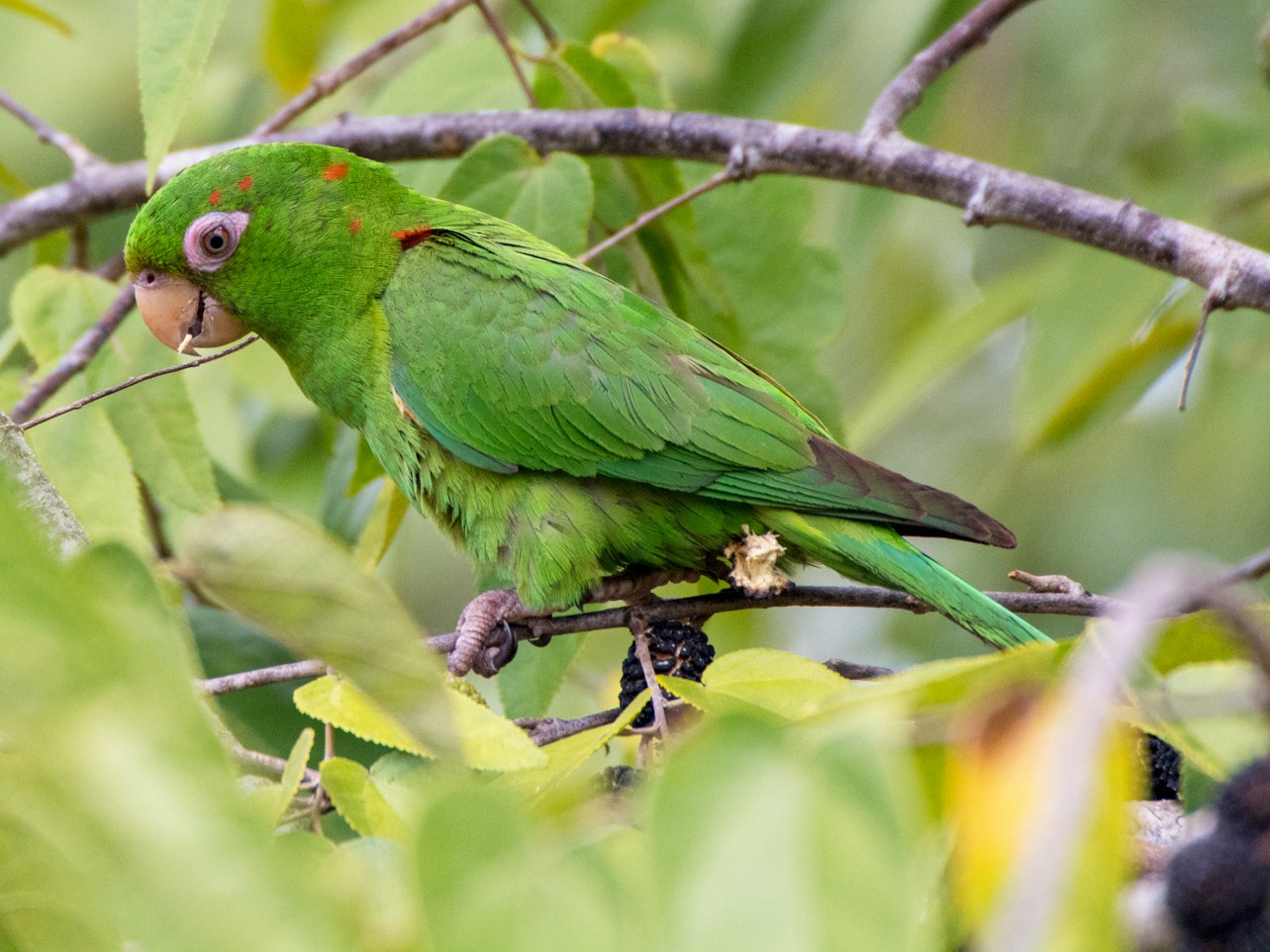
If you liked this article about Tropical Birds and want to learn more about other interesting topics, you can check the following links: